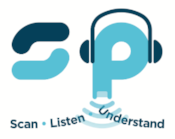Study of an 8-year-old child with dyslexic tendencies and the C-Pen Reader for every day classroom based work
Supporting young children with dyslexic tendencies is not only a worry for parents, but also for teachers as cited in an article from Dyslexia Action (2017)2. 74% of those teaching dyslexic children feel dissatisfied with their initial teacher training, questioning whether if it provides them with the skills to identify and teach children with dyslexia. Often dyslexic children are incredibly skilled and intelligent; therefore, it is imperative early identification of dyslexic tendencies are recognised to enable the implementation of the right teaching/learning style for that child (as recommended by educational psychologist Dr. Gavin Reid (2017))7. However, reading problems can occur due to other issues such as medical and learning difficulties. Early identification of dyslexia can prove to be challenging.
When a clear identification has been achieved, teachers require a bag of strategies and knowledge such as access to supportive guides; for example, the Dyslexic Screener (available online)3; awareness and instruction on the use of up- to-date available assistive technology; which in turn will enable them to support the dyslexic child; and confidence to explore the child’s learning styles to help the child reach their full potential. Finally, the teacher will need to understand the individual child’s emotional well-being, Rosie Bissett, (Dyslexia Ireland chief executive cited in Irish Examiner, 2017)8 recently stated “It is crucial that teachers understand dyslexia while at the same time having expectations for the child…”.
There are several research papers relating to assistive technology and students with learning disabilities; livescribe pen, (Harper et al. 2016)4 android software platforms, (Tariq et al. 2016)9 mobile learning (Alghabban et al. 2016)1. However, many of these devices are aimed at the older student. Studies involving primary aged children focus on computer-based training programmes rather than smaller hand-held devices which may encourage independence.
This study evaluated existing dyslexic teaching strategies; sounding out, phonics, learning words from sight, multi-sensory activities and aligning these tried and tested approaches with a device which promotes independent learning; the C-Pen Reader.
A further focus for this study was to gain understanding of how a primary aged child could develop independent skills and habitual behaviours which would support their future educational journey. The dyslexic child requires continual feedback to confirm their success, they require extra time; to enable others to listen to them read; and they need to be motivated.
Extra time to practice reading and sounding out text is of great import to the dyslexic child, followed by confirmation from the adult (who often will have 20-30 other children in the classroom), before continuing with their work. Obviously, this impacts on the dyslexic child’s chance of achieving all the work set in each lesson due to the extra minutes they require to ensure they are confident with their learning. The C-Pen Reader was deemed the perfect device to promote such efficiency, with confirmation coming from the pen rather than an adult.
The research question: “How effective would the early introduction of assistive technology be to the primary aged child, to encourage emotional development, independent learning and lead to positive reading outcomes?”
